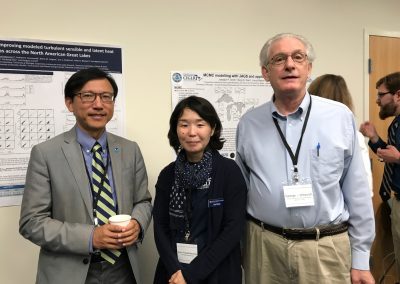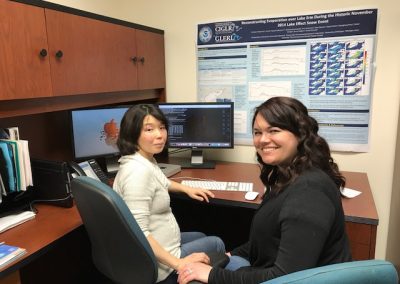Ayumi Fujisaki-Manome
Associate Research Scientist
4840 South State Road
Room 305
Ann Arbor, MI 48108
In the News:
- Featured Research: CIGLR Research Continues to Support NOAA’s Mission; Begins Phased Return to Critical Fieldwork, CIGLR Spring 2020 eNews, 06/2020
- Working from H.O.M.E.S.: Great Lakes Research is Challenged but Carries On, CIGLR Winter 2020 eNews, 04/2020
- Catalyzing Change in Sustainability: UM Graham Institute Issues Grants, The Michigan Daily, 1/17/2019
- November 2014 storms become case study for better lake-effect forecasting, The Buffalo News, 12/9/2017
- Building a better lake-effect snow forecast, GoErie.com, 12/1/2017
- Better lake-effect forecasts are coming, The Buffalo News, 11/24/2017
- Imagine a Great Lakes weather forecaster who’s always right, Great Lakes Echo, 11/20/2017
Photo Gallery
CIGLR Assistant Research Scientist Ayumi Manome presents her poster titled: Evaluating and Improving Modeled Turbulent Sensible and Latent Heat Fluxes Across the North American Great Lakes. Photo Credit: Michele Wensman.
L-R: GLERL Scientist Philip Chu, CIGLR Assistant Research Scientist Ayumi Manome and GLERL Scientist George Leshkevich enjoying the poster session. Photo Credit: Michele Wensman.
CIGLR’s Assistant Research Scientist Ayumi Fujisaki-Manome (left) and Atmospheric Data Analyst Linsay Fitzpatrick (right) working together on data coding and analysis. Photo Credit: Michele Wensman.
Researcher Profile:
Ayumi Fujisaki-Manome’s research program aims to improve predictability of hazardous weather, ice, and lake/ocean events in cold regions in order to support preparedness and resilience in coastal communities. The main question my research aims to address is: what are the impacts of interactions between ice and oceans / ice and lakes on larger scale phenomena, such as weather, storm surges, and sea/lake ice melting? I primarily use numerical geophysical modeling to address my research question; and scientific findings from my research feed back into the models and improve their predictability. My work has focused on applications to the Great Lakes, Arctic Ocean, the Alaskan coastal region, and the Sea of Okhotsk.
Education:
- Bachelor Degree in Engineering, Keio University (2004)
- Master Degree in Ocean Engineering, University of Tokyo (2006)
- Ph.D in Ocean Engineering, University of Tokyo (2009)
Research Interest/Area of Expertise:
- Polar physical oceanography
- Numerical geophysical modeling
- Sea/lake ice and lake effect snow
Recent Publications:
Saiki, R., H. Mitsudera, A. Fujisaki-Manome, N. Kimura, J. Ukita, T. Toyota and T. Nakamura. A Mechanism of Ice-Band Pattern Formation Caused by Resonant Interaction between Sea Ice and Internal Waves in a Continuously Stratified Ocean. Progress in Oceanography. (DOI:10.1016/j.pocean.2020.102474). [Altmetric Score]
Fujisaki-Manome, A., E.J. Anderson, J.A. Kessler, P.Y. Chu, J. Wang and A.D. Gronewold. 2020. Simulating impacts of precipitation on ice cover and surface water temperature across large lakes. Journal of Geophysical Research Oceans. 125, e2019JC015950. (DOI:10.1029/2019JC015950). [Altmetric Score]
Fujisaki-Manome, A., G.E. Mann, E.J. Anderson, P.Y. Chu, L.E. Fitzpatrick., S.G. Benjamin, E.P. James, T.G. Smirnova, C.R. Alexander and D.M. Wright. 2020. Improvements to lake-effect snow forecasts using a one-way air-lake model coupling approach. Journal of Hydrometeorology. (DOI:10.1175/JHM-D-20-0079.1). [Altmetric Score]
Recent Presentations:
Fujisaki-Manome, A., E.J. Anderson, J.A. Kessler, G.A. Lang, J. Wang and P. Chu. 2018. Impacts of Sensible Heat from Precipitation on Ice Cover in Large Lakes, AGU Fall meeting, Washington D.C., December 10th-14th, 2018.
Anderson, E.J., A. Fujisaki-Manome, J.A. Kessler, P. Chu, J.G.W. Kelley, Y. Chen, G.A. Lang and J. Wang. 2018. Ice Forecasting in the Next-Generation Great Lakes Operational Forecast System (GLOFS). ECM15, 2018, 15th Estuarine and Coastal Modeling Conference, Seattle, Wash., June 25-27, (2018).
Chu, P., E.J. Anderson, S. Benjamin, G.E. Mann, A. Fujisaki-Manome and L.E. Fitzpatrick. 2018. Improving lake-effect snow modeling and forecasting in the Great Lakes region. 22nd Annual Severe Weather Symposium sponsored by the Ohio Union at The Ohio State University, Columbus, Ohio, March 9, (2018).
Video Library
.
Lake effect snow storms have huge impacts on transportation, public safety and business revenue. Recently, great improvements have been made to forecasting lake effect snow and scientists from CIGLR are a part of it. Dr. Ayumi Fujisaki-Manome, CIGLR Assistant Research Scientist, and Lindsay Fitzpatrick, CIGLR Atmospheric Data Analyst, recently collaborated on an article that discusses instruments and models that can help improve the accuracy of lake effect snow forecasting.
.




